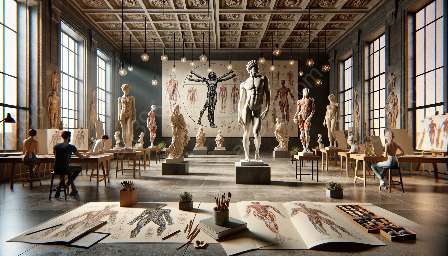As a multidisciplinary field, the convergence of facial anatomy for artists and artistic anatomy provides a fascinating platform for understanding the features of aging in facial anatomy and how they can be realistically depicted in art. Aging brings about a myriad of changes to the face, including the appearance of wrinkles, sagging skin, and changes in facial proportions. Understanding these changes is crucial for artists who seek to depict the human form realistically and convincingly.
Features of Aging in Facial Anatomy
Age-related changes in facial anatomy are often characterized by a loss of volume, changes in skin elasticity, and alterations in the underlying facial structures. Key features of aging in facial anatomy include:
- Wrinkles and Fine Lines: As individuals age, the formation of wrinkles and fine lines becomes more prominent due to a reduction in collagen and elastin production, as well as repetitive facial movements over time.
- Sagging Skin: The loss of skin elasticity and the effects of gravity lead to the appearance of sagging skin, particularly around the cheeks, jawline, and neck.
- Changes in Fat Distribution: The redistribution of facial fat can result in hollowed areas and a loss of youthful fullness, particularly in the cheeks and under the eyes.
- Alterations in Bone Structure: The bones of the face undergo subtle changes with age, such as resorption and changes in shape, which can affect overall facial proportions.
Realistic Depiction in Art
Depicting the features of aging in facial anatomy realistically in art requires a deep understanding of the underlying anatomical changes and their visual manifestations. Artists can employ various techniques to capture the essence of aging in their artworks:
- Study of Facial Anatomy: Artists should study the anatomy of the face in detail, exploring the underlying structures and how they change with age. This knowledge forms the foundation for accurately depicting aging features.
- Observational Drawing: Observing real-life models and understanding how aging affects their facial features can provide valuable insights for artists. Close observation of wrinkles, skin texture, and changes in expression is essential.
- Understanding Light and Shadow: Aging features often create distinct patterns of light and shadow on the face. Artists should master the use of light and shadow to create depth and convey the effects of aging.
- Use of Textures and Materials: Experimenting with textures and materials, such as different drawing tools and painting techniques, can help artists simulate the textures of aged skin and create depth in their artwork.
- Emotional Context: Aging is not just about physical changes; it also carries emotional depth. Artists can depict the emotional nuances and wisdom that come with age through facial expressions and subtle cues.
Conclusion
Understanding the features of aging in facial anatomy and how to realistically depict them in art is an enriching journey that merges the worlds of facial anatomy for artists and artistic anatomy. By delving into the intricacies of aging features and mastering the techniques required to portray them, artists can breathe life and authenticity into their representations of the human face, capturing the essence of time and experience.

